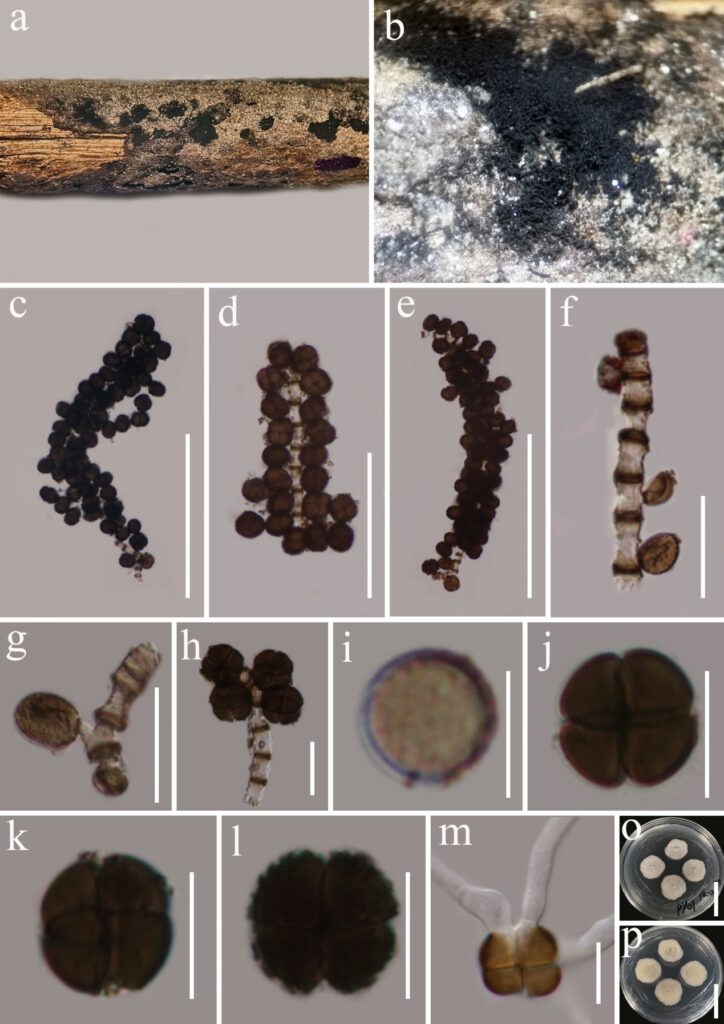Dictyoarthrinium thailandicum G.C. Ren & K.D. Hyde, in Ren, Wanasinghe, de Farias, Hyde, Yasanthika, Xu, Balasuriya, Chethana & Gui, Biology 11(no. 1660): 15 (2022)
Index Fungorum number: IF 559807; Facesoffungi number: FoF 10705
Etymology ‒ The species epithet “thailandicum” refers to the country where the species was collected.
Holotype ‒ KUN-HKAS 122785
Saprobic on dead woody twigs of Castanopsis sp. Sexual morph: Undetermined. Asexual morph: Colonies solitary, irregular, black. Mycelium superficial, septate, branched, anastomosing hyphae. Conidiophores 130–220 × 4–5 μm (x̅ = 180 × 4.5 μm, n = 25), erect, macronematous, basauxic, cylindrical, straight or flexuous, subhyaline to pale brown, the transverse septa partly brown with distances of 3–7 μm, rough-walled. Conidiophore mother cells 4–4.5 × 3.8–4.1 μm (x̅ = 4.5 × 4 μm, n = 10), cup-shaped, pale brown. Conidiogenous cells 3–7 × 3–5 μm (x̅ = 5 × 4 μm, n = 20), blastic, integrated, terminal and intercalary, cylindrical, subhyaline. Conidia 9–11 × 8.5–10.5 μm (x̅ = 10 × 9.7 μm, n = 30), solitary, holoblastic, 1-celled and subhyaline to pale brown at young, cruciately septate with 4-cells, constricted at the septa, rounded at the ends, spherical or subspherical, brown to dark brown at maturity, verrucose, mature conidia split along one line of the septa, arising from the lateral or apical part of conidiophores.
Culture characteristics ‒ Colonies on PDA, reaching 15–20 mm diam. in 14 days at room temperature (25–30 ℃), superficial, circular, umbonate at the center, surface rough, with dense mycelia, velvety, flat, from below and from below white.
Known distribution ‒ Castanopsis sp. (Thailand)
Material examined ‒ Thailand, Chiang Mai Province, Yang Piang Omkoi, on dead woody twigs of Castanopsis sp., 25 August 2019, G.C. Ren, TSY02 (KUN-HKAS 122785, holotype), ex-type culture KUMCC 21-0665; YP01 (KUN-HKAS122784, paratype), ex-paratype culture KUMCC 21-0664.
Notes ‒ Dictyoarthrinium thailandica is introduced as a new species based on its distinct morphology and the phylogeny of combined SSU, LSU, ITS, tef1-α dataset. Dictyoarthrinium thailandica is phylogenetically distinct from other Dictyoarthrinium species and formed a sister clade to D. musae with 1.00 PP bootstrap support (Fig. 1). Our species is similar to Dictyoarthrinium musae by having black colonies, cup-shaped conidiophore mother cells and cylindrical conidiogenous cells. However, the size of the conidiophores and conidia of Dictyoarthrinium thailandica (180 × 4.5 µm, 10 × 9.7 μm) are comparatively larger than those of D. musae (81.5 × 1.6 μm, 8.7 × 7.9 µm) (Samarakoon et al. 2020b).

Figure 5 ‒ Dictyoarthrinium thailandica (KUN-HKAS 122785, holotype) a, b Conidia on the host. c–e Conidia with conidiophores on stalk. f–g Developmental stage of an immature lateral conidium. h Four-celled terminal conidium. i–l Warted four-celled mature conidia. m Germinated conidium. o, p Culture characters on PDA. Scale bars: c, e = 100 μm, d = 50 μm, f–h = 15 μm, i–m = 10 μm, o, p = 30 mm.
